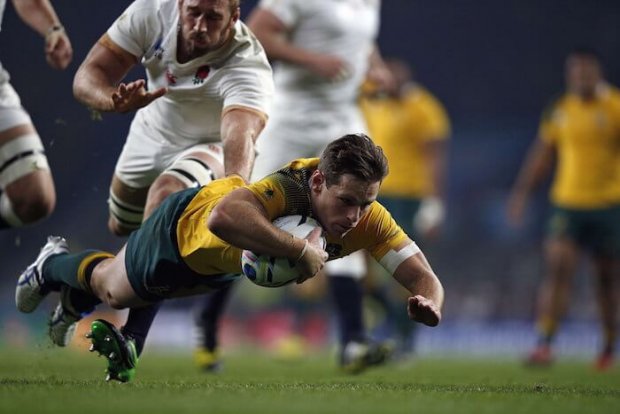There are a bunch of things we could focus on in the Australian defeat of England, the scrum, the defence, the breakdown. All valid discussion points, but I’m English and before I erase this horrible game from my hard drive, and memory, for ever, I’d like to focus on how wonderfully simple and well executed the Australian game plan was.
It was about as good an example as you’ll ever find of just getting the basics right and letting the rest takes care of itself. Out of the window went complex lineout calls and screened passing moves – in came territory, solid set piece and players attacking space. Nowhere better was this demonstrated than with the (real) man of the match Bernard Foley’s second try.
Leading into this game there was some discussion about what the Wallabies had been holding back in the way of strike moves and plays. The answer is, not that much, this is it.
If it wasn’t before it’s abundantly clear now that the Wallabies have been using the last few games to slowly develop a game plan that all 31 players understand, buys into and are able to execute. For example, Rob Horne goes off, Beale comes on and knows his role, knows what’s expected of him and delivers a line break that Drew Mitchell would be proud of. Hell, scratch that one week earlier Drew Mitchell was proud of it as we saw the same split field attack pattern they used against Uruguay deployed against England.
Likewise, Hooper steps out, McMahon or McCalman can step in without the team readjusting and changing tact. The complete polar opposite of England it has to be said.
When it all boils down to it the simplicity of the Australian game plan allows the players to just concentrate on their core skills and express themselves on the field and they seem all the better for it.
The try itself comes from that Split field set up we mention earlier. Line out just outside the 22, Moore taps Pocock on the side to give him the signal to break and as he comes around they split and go at the 10 channel. Genia plays the same side and then once midfield they rewind back and Foley and Beale combine to pry England’s defence open.
Split fields are nothing new, New Zealand do it all the time as we saw against Namibia, but what I loved about this try was how Foley and Beale use that set up to just identify and exploit a 2 vs 1.
Cast your mind back to all the times your coach had you doing those boring as hell single channel 2v1, 3 v2 drills. You know the ones, a long narrow channel with one maybe two defenders stood behind each other, you run down the channel beat them or throw the dummy. Then look at how Foley and Beale tear through England here. Forget everyone around them, just look at how Foley moves Youngs off his defensive line, Beale hits that space, Foley maintains depth and tracks Beale, Beale draws Brown and Foley is in the clear.
It’s just your classic 2vs1 drill in a game situation.
Of course, I’m over simplifying (there is that word again) things a little, there is clearly more to international rugby than what you do at training at your local rugby club, but not by much.
So it’s a good position Australia find themselves in, performance of the tournament by far. It will be interesting to see how Wales take them on, will they stick to the power game or run the dual open side model? Hard to tell, but I think both teams will be keen to top the pool and avoid the other side of the draw.
As for England? The results are probably not reflective of where they really are. That’s not to say they don’t have issues, they certainly do and lots of soul searching to do between now and the six nations. Possibly even a new coaching team. But they do have a lot of good young players coming through, guys who have dominated at U20’s level and will be stronger for some of the older heads rotating out.
But just past that, on the not to distant horizon is a three test series against Australia, I reckon that could turn out to be some test series.


